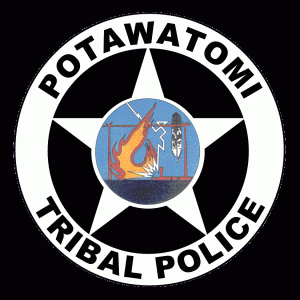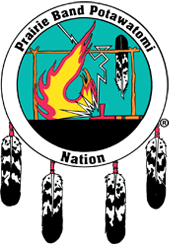
9.2.20 | Courtesy of the PBP Tribal Police Department
The Prairie Band Potawatomi Tribal Police Department would like to pass on some important information regarding your new 911 telephone service. Effective September 1, 2020, we are now a 911 dispatch. None of us want to call 911, but statistically, most people have a need, at some time in their life, to make that call.
The Prairie Band Potawatomi Tribal Police Department is the only 24/7 public safety answering point (PSAP) within the jurisdictional boundary of the Prairie Band Potawatomi Tribal Nation. The Communications Center is solely responsible for answering all emergency calls for service and dispatching emergency apparatus for the Prairie Band Potawatomi Tribal Police, Prairie Band Potawatomi Tribal Fire/EMS.
Additionally, inbound 911 calls for the Prairie Band Potawatomi Tribal Fire/EMS and wireless calls within the jurisdictional boundary of the Prairie Band Potawatomi Tribal Nation will be handled and routed through the Communications Center.
What is 911?
It is the preferred number to call within the jurisdictional boundary of the Prairie Band Potawatomi Tribal Nation to obtain help from police, fire, or medical emergency.
When Should You Use 911?
Only use 911 in emergency situations. An emergency is any situation that requires immediate assistance from law enforcement, the fire department, or an ambulance. If you are ever in doubt as to whether a situation is an emergency, you should call 911. It is better to be safe and let the 911 call taker determine if you need emergency assistance.
If a 911 call is made by mistake, do not hang up. Tell the call-taker what happened so they know that there really isn’t an emergency. If you hang up, law enforcement officers will be dispatched to check on the call. While they are responding, a call taker will try to call you back and find out what’s going on. Please help us manage our emergency resources by being careful not to call 911 by mistake.
The Prairie Band Potawatomi Tribal Police encourage you to call 911 to ensure that all databases are working correctly. If you have recently moved into a new residence or have gone through an address change, please dial 911 within 30 days. Let the dispatcher know that you do not have an emergency but would like to confirm that your address is correct in the database. (This applies only to landline phones). It should be noted that this should be the only time you should call 911 for a non-emergency call.
When you dial 911 from a traditional phone or “landline,” a dispatcher views a screen that provides:
- The phone number you’re calling from
- The name associated with the phone line
- The address you’re calling from
The dispatchers will ask you to verify the information so that they can send help to the correct location. If you are calling from a multi-line phone system/Voice over IP (VOIP, usually found in office buildings), it may be difficult for dispatchers to determine your location. Always advise the dispatcher your location within the building.
When you dial 911 from a wireless or cell phone, the dispatchers view a screen that provides:
- The cell phone number and the address of the cell site that your phone accessed.
- In some cases, we can obtain GPS coordinates of your location while you are calling.
Cell phones are convenient and can be very useful if an emergency arises. However, for all that they help, cell phones also come with complications.
If your wireless phone is not “initialized,” (you do not have a contract for service with a wireless service provider), and your emergency call gets disconnected, you must call the emergency operator back because the dispatch center will not have your telephone number and cannot contact you.
In the event you are unable to make a voice call from a mobile device, the Prairie Band Potawatomi Tribal Police Department Communications Center is now prepared to accept texts to 911.
A few possible scenarios where a text to 911 may provide advantages over a voice call are:
- The caller is facing a threatening situation and a voice call could increase the threat.
- The caller is injured or suffered a medical condition and cannot speak.
- The caller is in a remote location and can only send out text messages.
When texting to 911, callers should always include their location and the nature of the emergency in their initial message. Avoid using slang, and abbreviations as this may be difficult for the dispatcher to interpret, and delay response.
For more information, please call the Prairie Band Potawatomi Tribal Police Department at (785) 966-3024.
Please note the history about the Next Generation 911 implementation through Federal legislation and the State of Kansas listed below:
Next Generation 911
(https://www.911.gov/issue_nextgeneration911.html)
Because most 911 systems were originally built using analog rather than digital technologies, public safety answering points (PSAPs) across the country need to be upgraded to a digital or Internet Protocol (IP)-based 911 system, commonly referred to as Next Generation 911 (NG911).
The success and reliability of 911 will be greatly improved with the implementation of NG911, as it will enhance emergency number services to create a faster, more resilient system that allows voice, photos, videos and text messages to flow seamlessly from the public to the 911 network.
NG911 will also improve PSAP ability to help manage call overload, natural disasters, and transferring of 911 calls and proper jurisdictional responses based on location tracking.
While the technology to implement these new IP-based 911 systems is available now, the transition to NG911 will involve much more than just new computer hardware and software. Implementing NG911 in states and counties nationwide will require the coordination of a variety of emergency communication, public safety, legislative and governing entities.
2015, Kansas Latest to Implement Statewide Next-Gen 911
( https://www.govtech.com/public-safety/Kansas-Latest-to-Implement-Statewide-Next-Gen-911.html)
Kansas has joined a handful of other states, including Connecticut, Massachusetts, and Maine, in implementing next-generation 911 (NG911) systems designed to deliver faster, more reliable communications for emergency workers. The Kansas 911 Coordinating Council expects the NG911 system to boost the speed, security, and reliability of communications between operators, dispatchers, and first responders.
NG911 is an Internet protocol (IP)-based system designed to provide access to emergency services from virtually all connected communications sources. It also provides multimedia data capabilities for 911 call centers, or Public Safety Answering Points (PSAPs), and other emergency service organizations.
“The legacy 911 system has served the citizens of Kansas very well and continues to do so for voice calls,” said Dick Heitschmidt, chairman of the Kansas 911 Coordinating Council. “[But the] legacy 911 system is a voice-centric system and is not capable of accepting the methods of communication that our citizens use today.”
Because citizens often communicate with their friends and family via text and picture messaging, they expect to communicate with 911 in those same ways, according to Heitschmidt. To meet these expectations, the state has decided to migrate from outdated legacy technology to an IP-based network platform.
AT&T is building the system, which will combine wireless and private cloud service. Emergency call takers will then access the cloud via a secure, high-speed connection. First responders, PSAP dispatchers, and operators will have near real-time access to 911 event data from any connected location.
The new system will also include Airbus DS Communications’ VESTA 911 call processing solution, which will support the state’s 348 call taking positions and 117 PSAPs and allow seamless communication between cities, counties, and municipalities.
The first phase of the project was the development of a statewide, seamless GIS database for call location mapping, explained Heitschmidt. To facilitate development, the Kansas 911 Coordinating Council implemented a GIS Enhancement Project. GIS data was gathered from all PSAP jurisdictions and compared to an NG911 GIS data standard, developed by the Council’s GIS Committee. Variations from the standard were identified and remediated by GIS companies contracted by the Council.
Once remediation is complete, the data is submitted for a quality assurance audit to verify that the remediation efforts brought the GIS data into compliance with the standard. At present, 72 of the 117 PSAP jurisdictions have completed the quality assurance audit. The remaining PSAP jurisdictions are expected to complete the process by the end of 2015.
Phase two of the project, currently underway, develops IP network connectivity between the PSAPs and a hosted call handling solution that can be shared among the PSAPs, said Heitschmidt. Concurrently, the third phase of the project is in the planning stage and will deliver text messages to the PSAPs that are connected to the statewide system. This phase of the project is expected to be delivered to the PSAPs within six to eight months of their coming onto the statewide platform.
The fourth and final phase of the project will be the migration to geospatial call routing. This phase is expected to begin in late 2017 to early 2018, with full migration in the 2019 to 2020 time frame.
Beyond that, SMS messaging, incorporation of third-party databases and machine-to-machine communications are expected to be added to the statewide platform as the standards for these enhancements become available.
Total costs for the statewide emergency system upgrade are estimated to be $27 million over five years, according to Walter Way, chair of the state’s 911 Coordinating Council.
NG911 will also improve the overall resiliency of the state’s 911 system, explained Heitschmidt. For example, if a tornado takes down one of the PSAPs, another can immediately take over.
“With the shared system, redundancy of equipment is built into the system design, which could not be achieved cost-effectively at the individual PSAP level,” Heitschmidt said. “Additionally, because it is a shared system, personnel assets can be more easily shared from PSAP to PSAP, and continuity of operations planning is greatly simplified, without degradation of service capabilities.”
The shared nature of the system allows a 911 operator to log onto any workstation on the system as if they were in their home PSAP. This logon will deliver their home call handling screen and their 911 calls to the workstation that they are logged onto, without the need to reroute calls or do anything in addition to the logon.
“This ability makes emergency operations much more efficient,” said Heitschmidt.
The biggest challenge with the project thus far has involved PSAPs within the state that are currently utilizing a call handling platform no longer supported by the manufacturer, explained Heitschmidt.
“These PSAPs are faced with the possibility of failure of their call handling platform, with no option for repair,” he said. “We have handled this situation by prioritizing these PSAPs as our first installations of the new call handling system.”
Hutchinson-Reno County Emergency Communications and Cowley County Emergency Communications will be the first two PSAPs brought on to the statewide system this summer.
Heitschmidt suggested that other states considering moving to an NG911 system start by developing a vision of what their state’s NG911 offering should look like and then looking for vendors that will fulfill that vision. Beyond that, he suggests states reach out to local units of government and draw on their resources for planning and project development support.
“In Kansas, we have a 26-member Coordinating Council made up of local government employees and elected officials, state Legislature representation, and telephone company representation (wireline, wireless, and VoIP [voice-over Internet Protocol]),” he said. “All of these individuals are volunteers and are not compensated for the time that they put into NG911. It has been incredible to see the amount of time and dedication that these folks have committed to our statewide project. The commitment they have made has made it much easier to obtain buy-in from the PSAPs toward the statewide system approach.”
